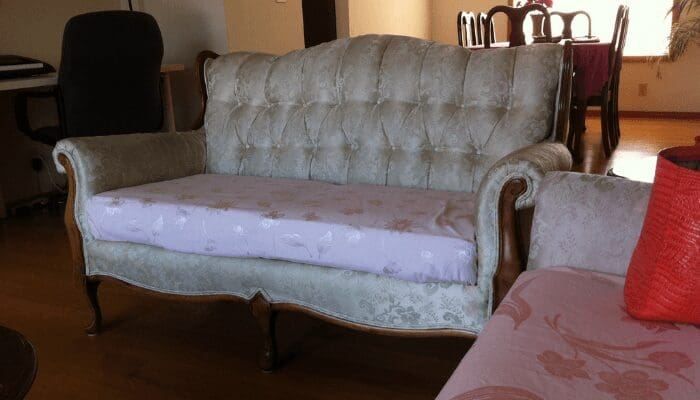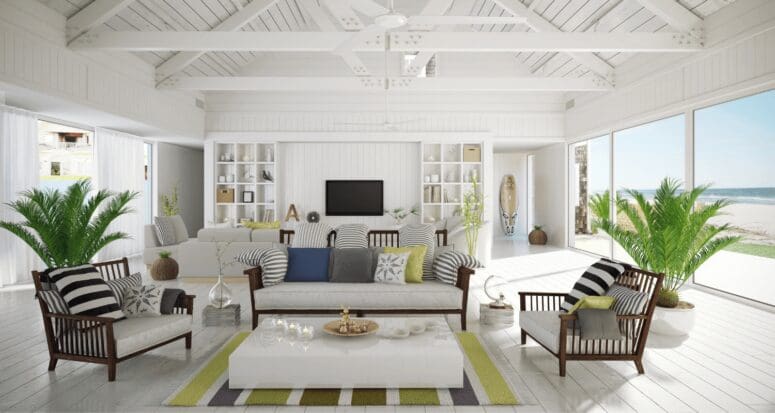Staging a Beach House to Sell Fast: Think Modern Coastal, Not Jimmy Buffett
- Published on
- 6-7 min read
-
 Christine Bartsch Contributing AuthorClose
Christine Bartsch Contributing AuthorClose Christine Bartsch Contributing Author
Christine Bartsch Contributing AuthorFormer art and design instructor Christine Bartsch holds an MFA in creative writing from Spalding University. Launching her writing career in 2007, Christine has crafted interior design content for companies including USA Today and Houzz.
Tiki torches, splashy Hawaiian prints, bamboo furniture, and booze in the blender—the “Margaritaville” lifestyle may be perfect for hanging out in your beach house, but it’s not the right vibe if you’re looking to sell your vacation home.
Achieving the stress-free beach house look is as simple as understanding the latest take on the relaxed look: modern coastal.
What is Modern Coastal?
Modern coastal style is rooted in its anchor interior design style: modern. Modern interior design embraces:
- A streamlined, minimalism aesthetic
- A light, airy, neutral color palette—especially whites and cool blues
- Natural, neutral materials and finishes, such as wood and canvas
- Manufactured, futuristic materials, including chrome and molded plastic
- Geometric shapes (both straight-edged, boxy shapes, and the mathematically precise curves of circular shapes)
When you add coastal style to modern, you’re amping up the number of natural materials, and selecting weathered finishes reminiscent of wood and canvas beach chairs left seaside for too long.
Let’s take a look at just a few examples of modern coastal style:

Warm up a cool, neutral room with the cozy texture of a whitewashed, shiplap feature wall.

Soften boxy, geometric furniture with the organic lines of a driftwood coffee table.

Brighten up your dark, nautical blue sofa with some neutral, coastal throw pillows.

Add cozy coastal style to a sleek, modern kitchen with knotted rope pendant lighting.

Add beach-y and nautical textiles without getting kitschy by selecting bamboo, rattan and wicker furniture with modern lines.
Understanding modern coastal style is easy. Achieving the modern coastal look on your own will take some work.

7 tips to bring in beach house chic when staging your vacation home
Stressed out by what it’ll take to transform your beach house? True, staging your vacation home may take time, effort, and money, but it’s definitely worth it.
“Staging works because it helps buyers envision how their family will enjoy spending time at this beach house,” says Peter Sollecito, an agent in Myrtle Beach, South Carolina area. “Staging will certainly help that property sell a lot quicker than a vacant property.”
There’s an oceans worth of ways to capture the modern coastal style—and you won’t need a pro stager to achieve the look if you follow these seven tips.
1. Show off your beach views (if you’ve got ‘em)
“When people buy beachfront property, even if they’re buying the second row, the goal is to have great views of the water and the beach from the house. So, your staging needs to highlight those views,” explains Sollecito.
Indoor/outdoor window sheers in a crisp, sailboat sail frame your serene seaside views and let in lots of light. You can finish the modern coastal look with a natural, bamboo shade that can be rolled up to show off the view during the day.
Note, however, that water reflects and amplifies sunlight, which heats up your beach house and may cause any furniture in the paths of the sun to fade. Use privacy window films—which uses one-way vision technology to make living environments more comfortable—to allow for ideal ocean views from the inside, and daytime privacy and sun protection from the outside.
2. If you don’t have a view, hang artwork that highlights local sights
If you’re marketing your tourist-town home as a beach house to vacation-minded buyers, but you don’t have the advantage of ocean or lake views, hang large paintings or photos of your local beaches and nautical sights (think docks, sand dunes and lighthouses) on your walls.
This both serves to add a touch of modern coastal décor, and pulls double duty as a reminder to buyers of the reason why they’re buying your house.
Don’t, however, blow up snapshots of your family enjoying your local attractions.
“You don’t want to have photos of your family at the beach everywhere,” says Sollecito. “You don’t want buyers focusing on your family, you want the buyer to come in and imagine themselves vacationing there.”
You shouldn’t have to look far to find affordable local artwork for your walls.
Since your beach town is a tourist attraction, you’re apt to find dozens of local artisans and photographers creating scenic beach-inspired artwork at affordable prices. Just take a stroll along the boardwalk, or check your local art galleries and gift shops for photos of the ocean, or artistic renderings of local sights.

3. Keep the kitschy beach décor to a minimum
“When you’re staging to sell, you want the décor to be neutral, so don’t go overboard with kitschy décor. Your beach house doesn’t need to look like an aquarium,” advises Sollecito.
The coastal in modern coastal is borderline theme-y, so it’s tricky to tell the difference between coastal décor that’s chic and the stuff that’s over-the-top tacky.
Here are two words to help you pick out the right modern coastal décor accents: authentic and subtle.
Picture a modern kitchen that needs a little coastal décor to bring in the beach house vibe. This could go one of two ways:
- Chic: Hang a pair of weathered oars on the wall and add rope handles or boat cleat pulls to the cabinets with nods toward the nautical theme.
- Kitschy: Hang a giant fish sculpture on the wall and add knobs that picture images of ship’s wheels and anchors (too on-the-nose).
(Note: Stick with authentic-looking décor, like oars you could actually pull off the wall and use. That’s much more subtle and non-kitschy than cheesy, oar-shaped artwork.)
4. Don’t ignore the beach, though
With the weight of kitschy hanging over your head, it’s tempting to omit any ocean or nautical-inspired elements in your beach house décor, for fear of turning off buyers.
However, completely ignoring your locale’s best feature in your interior will make it harder for buyers to view your home as a beach house—which could could cost you.
A few beach, nautical, or coastal decorative accents are the best way to remind buyers that the beach is easily accessible, even if it’s not visible from the house.
“Obviously, location is going to determine the price. There’s a limited amount of beachfront property available, so it’s very scarce and very valuable,” explains Sollecito.
“If your beach house (is) actually on the beach, adding a little driftwood, or a few seashells to the décor is a great way to bring the seaside inside, without going overboard on beach-themed décor.”
That’s right. You can even add theme-y pieces like seashells and driftwood without the décor getting too kitschy. You just need to have a light touch when adding on-the-nose items. (Picture a mirror framed in driftwood or a handful of white seashells in neutral shadow boxes.)

5. Get rid of (or disguise) grungy, mismatched furniture
Between sand, the dampness, and all the freshly wet-from-the-waterplay bodies lounging on the furniture, it’s hard to keep crisp, neutral beach house décor looking nice.
That’s why your beach house is probably furnished with random, inexpensive thrift store finds in the first place. Comfortable, mismatched, even grungy furniture is fine in a beach house that you’re renting out to college kids on spring break.
However, when you’re getting ready to sell, the quality and style of your décor needs to match the price you’re asking for your beach house.
“Mismatched, dated furniture is definitely a beach house vibe killer. When you walk into some of these beach houses, you’ll see a mishmash of couches that look like they’re right out of J. R. Ewing’s office on that old TV show, Dallas,” says Sollecito.
“If your furniture just looks like a collection of a garage sale finds, buyers will focus on the décor of the property instead of the ocean views. If that happens, you’ve got a problem.”
When you’re selling an oceanside beach house filled with ratty, outdated furniture, it’s worth the money to hire a professional stager. A local pro stager will have a warehouse of stylish, non-kitschy beach-worthy furniture to capture the perfect, breezy modern coastal style in your beach house.
For sellers without the budget to hire a stager, or the money to throw out and replace your existing furniture, don’t worry.
All you need are a few slipcovers in beachy neutral hues and crisp, casual fabrics like canvas or cotton. Plus, slipcovers are a go-to decor trick designers use to capture the modern décor look.
6. Replace sand-trapping carpet with an easy-clean, hard-surface flooring
Carpet all throughout the living areas of a beach home is never a good idea.
“All buyers think about when they see carpet in beach houses is all the sand from feet and bathing suits that’ll become stuck in the carpeting,” says Sollecito.
Sand isn’t even your biggest issue if you’ve got carpet in your beach house. Waterfront properties (and even those in close proximity) are notoriously damp. That makes your carpeting a magnet for mustiness and mold.
For beachfront properties likely to fetch a high dollar, right-on-the-water price, go for high end, less warp-prone, hardwood options, like bamboo flooring.
If hardwood is too pricey for your budget, you can still get the cozy, modern coastal wood floor effect with wood plank look ceramic tiles, which are inexpensive and easy to clean, too.
7. Stage the outdoors to feel like vacation
Beach home buyers aren’t planning to sit around inside the house, so the backyard needs to have a great outdoor living area and feel like an extension of the vacation mindset.
The general rule is: don’t take on extensive renovations right before you sell. However, there are dozens of ways to DIY a built-in fire pit that’ll complement the exterior style of your beach house for just the price of a couple dozen pavers.
Alternatively you can create the illusion of a permanent backyard hangout spot with a portable, decorative firepit flanked by a couple of modern coastal patio chairs.
And don’t think that you need picturesque views to enjoy lounging in a modern coastal porch swing, or a rustic, nautical porch swing bed.

How to keep your vacation home staged if it’s a rental
Keeping a beach house clean and staged is relatively simple for sellers who are year-round residents. It’s not much of a challenge if no one but your family ever uses the place.
However, most vacation home owners don’t let their beach houses sit empty for most of the year.
“No one washes a rental car,” explains Sollecito. “So if you are selling a beach house that you rent out most of the time, we want to show the property in between renters, and definitely after the cleaning crew has come through.”
When you’re selling a beach house that you rent out, you’ll probably sell it faster if you suspend renting it out once it’s listed for sale—because it’ll be available for showing whenever a buyer is interested in seeing it.
If you need the continued rental income, consider a compromise that limits the rental availability to weekends only, say Thursday through early Sunday. That’ll leave your beach house open for showings for most of the weekdays.
While that schedule may not be completely convenient for buyers, you are providing a consistent timeline to schedule showings when it’s clean, vacant, and properly staged.
Beach house staging at its finest
It’s easy to go overboard on cheesy, tacky, kitschy décor when you’re decorating a beach house—and that’s totally fine and wonderfully nutty fun when you’re interior designing to please your own tastes.
But when you’re looking to sell your beach house for top dollar, you need a chill, tasteful style like modern coastal that’ll appeal to a wide pool of beach-going buyers.
Header Image Source: (jovana veljkovic/ Shutterstock)
